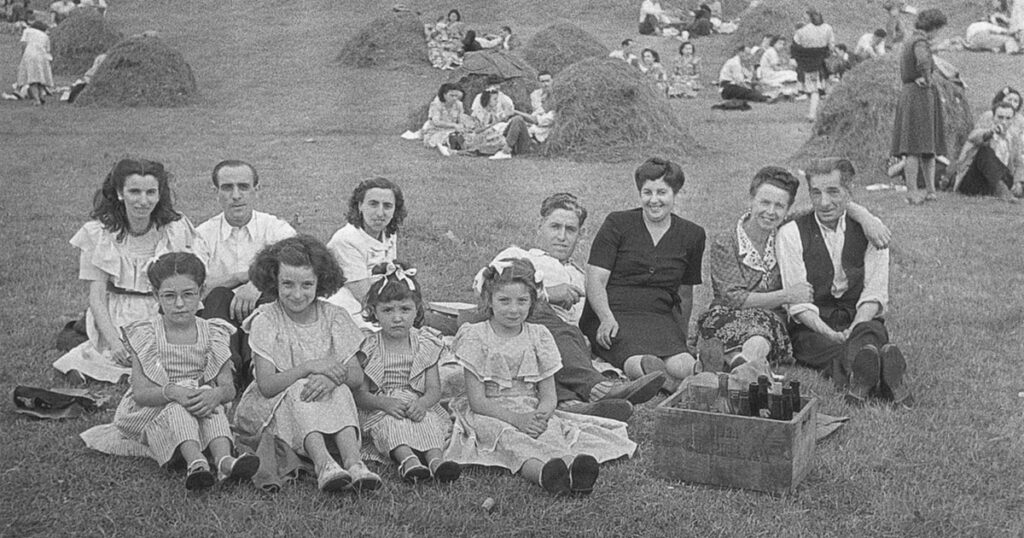
Folixa is Asturian for party, and one of the biggest of the summer in Asturias is El Carmín, in La Pola de Siero. How big is it? Fifty thousand people usually attend, according to the town’s write up, coming principally for the romería, a big picnic in a big field, the culmination of five days of festivities. I knew the date was nearing when one July afternoon, while walking by the field where the Carmín takes place, I noticed all the barbed wire had been removed from the fence posts enclosing it. Of course. You wouldn’t want a lot of drunken people walking blindly into the wire or entangling themselves in it as they try to leave the field.
Another day I saw that the grass was mown and the hedges along the lanes were trimmed. Some of the fence posts were later removed to give access to the trucks that a few days later brought a large dumpster and the many smaller sets of color-coded recycling bins for glass, paper, and plastic, which were placed all around the field. On the day of the romería, a Monday as always, trucks hauled in the stands that would sell food and drink, including a 40-foot-long bar set up under a canopy on the crest of the hill. Parallel lines of plastic tape pinned to the ground made aisles that crisscrossed the field—three adjoining fields, actually—to guide people through the area. The scene was set by midday. Groups began to arrive and stake out zones and mark their spots with folding chairs, coolers, blankets, and the ubiquitous black rubber buckets full of cider or beer. Except for the grass, it could have been a beach.
By the time I arrived, at seven in the evening, the field was full of young people—18 or 19 seemed the most common age—congregating in bunches beside their boxes of wine and beer and buckets of cider, a pile of sweaters at their feet in case the night grew chilly. The teens were the most conspicuous, but people of all ages were present, including whole families complete with babies and grandparents. Amid the throngs, I was looking for a group of acquaintances. I found them, set up under some massive chestnut trees. More and more people, many wearing the jeans, white T-shirt, and blue bandana that are the standard dress for the Carmín, were arriving from the town center, accompanying a parade of dancers and musicians. The field was full. And still they came.
Back in the center of town, a semi-trailer truck with a sound stage blocked the main road; by dusk it would be set up and the band would strike up. But for many, the best fun is on the grassy slope of the hill, La Sobatiella, where the Carmín is celebrated. But it hasn’t always been: the first fiesta was in 1696, at the village crossroads the year after Andrés del Quintanal Nosti built a shrine to Nuestra Señora del Carmen, Our Lady of the Carmen, beside a chestnut tree. Hardly a year has been skipped since, including during the Peninsular War and also in 1936, the year the Spanish Civil War began. Only Covid was its match.
Both shrine and tree are long gone, and the celebration has moved to the grassy Sobatiella. At the original site stands a metal statue of four dancers in a circle, hands raised and fingers snapping. The merrymakers of yore, dressed in their traditional garb and dancing the dances of their ancestors, would not recognize their present-day descendants, attired so differently and with such different notions of how to celebrate.
When I walked by the field at eight the next morning, I saw a sea of white from paper and plastic wrappers, napkins, and Kleenex. The field was full of broken glass. People, it seemed, hadn’t bothered to use those bright bins. The dirt roads leading to the field were also garbage-strewn. The ditches were filled with trash. What a huge mess. The 50,000 people attending the Carmín leave seven tons of garbage, it was reported last year. Not only garbage. The partiers leave their caches of unconsumed alcohol, which they can’t find in the dark, can’t remember to take home, or can’t be bothered to carry. They are lucky to walk away after a day of drinking, and no one, it seems, has any intention of bearing with them the cases and tubs full of cider, beer, and wine—to say nothing of the coolers, plastic chairs, blankets, sweaters, bags of snack food, and even a battered baby stroller that had been used as a cart. No matter. Nothing of value will go to waste. In the dark, even before the revelers have withdrawn, the resourceful people who make some money on lost objects and abandoned goods are already looking, gliding with headlamps through the field to carry off their finds. People were still scavenging when I passed by.
No one was raped or beaten up, no one was lost, no one fell into a ditch and broke a leg, and no one drowned in the river or was crushed on the train tracks in this year’s celebration, though I’d guess a lot of people had splitting headaches the next day. “What is the festival for?” a friend back home in the States asked after I sent before-and-after pictures of the field. For fun, I answered. For getting drunk, making a mess, having sex in the bushes, losing your purse and wallet, falling asleep in your car, and waking with a terrific headache the next day. Not one of those activities sounds appealing, but 50,000 people came by the carful, by the busload, and by packed trains to La Pola. Apparently, what’s hardly fun for one is plenty of fun for thousands. “Don’t you remember how appealing that once was?” I asked my friend. No answer.

